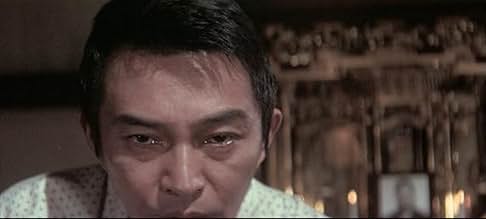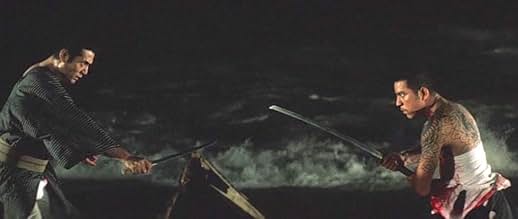Ajouter une intrigue dans votre langueAfter going to prison for killing the boss of the Kanno gang, a gangster gets released early - only to find that his ex-gang has merged with the Kannos. But with bitter resentments lingering... Tout lireAfter going to prison for killing the boss of the Kanno gang, a gangster gets released early - only to find that his ex-gang has merged with the Kannos. But with bitter resentments lingering on both sides, bloodshed is bound to begin anew.After going to prison for killing the boss of the Kanno gang, a gangster gets released early - only to find that his ex-gang has merged with the Kannos. But with bitter resentments lingering on both sides, bloodshed is bound to begin anew.
Histoire
Commentaire en vedette
I've said it in every review I've written about Hideo Gosha and I'll say it again. There's no Japanese director more criminally, terribly, shamefully underrated than the great Hideo Gosha. No director who soared in the artistic heights Gosha did is more underseen and undiscovered.
Following his early period of pulpy stylized chambaras, Gosha progressively tackled bigger, better and significantly more ambitious projects. This golden era that began so triumphantly with GOYOKIN, easily among the ten most stunningly beautiful Japanese films of all time, found its ultimate, irrevocable and titanic culmination in KUMOKIRI NIZAEMON, a film so labyrinthine, complex and breathtaking and so full of ideas as to contain enough material for two great movies. THE WOLVES is a step in that direction, part of that niche - ultra stylish, socially-minded, with a serpentine plot and epic in scope. Yet for that reason, a film best enjoyed by the Japanese cinema aficionado who is familiar with the often convoluted nature of these films. The novice might have to rewind the first 30 minutes a couple of times.
Indeed Gosha opens the film TOO fast. And then slows down to a crawl until the bloody finale. The opening narrative is an interesting experiment of Wellesian proportions, something that combines Kinji Fukasaku's ideas of montage and superimposed titles, yet in the same time takes them to the next level. Thirty years before Guy Ritchie would do it for quirk's sake, Gosha had already done it better.
A typical plot, perhaps intentionally generic, involves the rivalry and subsequent reconciliation between two yakuza families and all the scheming and backstabbing that slowly comes to the surface. Tatsuya Nakadai's character, a yakuza underboss fresh out of prison as the film begins after doing time for the murder of the rival family's boss in retribution for the bombing of his clan's log work site, ruminates at one point: "If I can't believe in his yakuza honor then what is left to believe in?". This is not a ninkyo chivalry yakuza film however, here the yakuzas are exactly what the title says. Ruthless thugs, street cutthroats throbbing with greed and ambition. People whose word is honorable as long as it serves them right, or as long as no one knows otherwise. At the root of all trouble, as with earlier Gosha films like SWORD OF THE BEAST and GOYOKIN, is gold.
The dualistic treatment of Tatsuya Nakadai's character, Iwahashi, also carries echoes of earlier Gosha characters like Magobei or Gennosuke. Disillusioned with his life and the hypocrisy of the yakuza, he's a tired middle-aged man who's laid ambition by the wayside. At the same time he's an instrument of revenge, an angel of death called to strike down with great vengeance. It's around this duality, passive and aggressive by circumstance, that Gosha builds the different moods of the movie: for most of the duration, the film languors in a dreamy haze lulling the viewer in a sense of false security through pictorial beauty. Yet, exposition is constant. Dark secrets behind the seemingly perfect alliance between the two ex-rival families slowly emerge and things are about to change.
For Gosha, as with other Japanese directors from the sixties, style IS substance. That is not to say the film lacks what is typically regarded as substance. Gosha has a story to tell, a premise to fulfill, a conclusion to arrive at. But he's a storyteller of visual excellence. To say Gosha's style IS substance is to advise the viewer to scan the frame for the details Gosha has planted there. Racking focus is one of his favorite tricks for example: watch how he shifts focus between a face, a hand that pounds a drum, and painted demons in the background of a carnival chariot, all in the same frame. Watch how the painted door panels comment on the foreground action in the final climax. Watch the overly theatric final showdown, one that blends Sergio Leone's ceremonial abstraction of the duel with Kabuki theater. Watch the topology he so carefully constructs: the carnival, a place of disguise, raw animal energy, intrigue and murder. The solitary beach strewn with the broken vessels of old ships, with seabirds flying over them: a dreamy limbo of sorts, a place for old lovers to reunite in, old friends and now foes to die in.
All in all, although THE WOLVES is not among Gosha's best films, it's just short of them, which makes it not just one of the best yakuza films of the time but also one of the best gendaigeki dramas.
Following his early period of pulpy stylized chambaras, Gosha progressively tackled bigger, better and significantly more ambitious projects. This golden era that began so triumphantly with GOYOKIN, easily among the ten most stunningly beautiful Japanese films of all time, found its ultimate, irrevocable and titanic culmination in KUMOKIRI NIZAEMON, a film so labyrinthine, complex and breathtaking and so full of ideas as to contain enough material for two great movies. THE WOLVES is a step in that direction, part of that niche - ultra stylish, socially-minded, with a serpentine plot and epic in scope. Yet for that reason, a film best enjoyed by the Japanese cinema aficionado who is familiar with the often convoluted nature of these films. The novice might have to rewind the first 30 minutes a couple of times.
Indeed Gosha opens the film TOO fast. And then slows down to a crawl until the bloody finale. The opening narrative is an interesting experiment of Wellesian proportions, something that combines Kinji Fukasaku's ideas of montage and superimposed titles, yet in the same time takes them to the next level. Thirty years before Guy Ritchie would do it for quirk's sake, Gosha had already done it better.
A typical plot, perhaps intentionally generic, involves the rivalry and subsequent reconciliation between two yakuza families and all the scheming and backstabbing that slowly comes to the surface. Tatsuya Nakadai's character, a yakuza underboss fresh out of prison as the film begins after doing time for the murder of the rival family's boss in retribution for the bombing of his clan's log work site, ruminates at one point: "If I can't believe in his yakuza honor then what is left to believe in?". This is not a ninkyo chivalry yakuza film however, here the yakuzas are exactly what the title says. Ruthless thugs, street cutthroats throbbing with greed and ambition. People whose word is honorable as long as it serves them right, or as long as no one knows otherwise. At the root of all trouble, as with earlier Gosha films like SWORD OF THE BEAST and GOYOKIN, is gold.
The dualistic treatment of Tatsuya Nakadai's character, Iwahashi, also carries echoes of earlier Gosha characters like Magobei or Gennosuke. Disillusioned with his life and the hypocrisy of the yakuza, he's a tired middle-aged man who's laid ambition by the wayside. At the same time he's an instrument of revenge, an angel of death called to strike down with great vengeance. It's around this duality, passive and aggressive by circumstance, that Gosha builds the different moods of the movie: for most of the duration, the film languors in a dreamy haze lulling the viewer in a sense of false security through pictorial beauty. Yet, exposition is constant. Dark secrets behind the seemingly perfect alliance between the two ex-rival families slowly emerge and things are about to change.
For Gosha, as with other Japanese directors from the sixties, style IS substance. That is not to say the film lacks what is typically regarded as substance. Gosha has a story to tell, a premise to fulfill, a conclusion to arrive at. But he's a storyteller of visual excellence. To say Gosha's style IS substance is to advise the viewer to scan the frame for the details Gosha has planted there. Racking focus is one of his favorite tricks for example: watch how he shifts focus between a face, a hand that pounds a drum, and painted demons in the background of a carnival chariot, all in the same frame. Watch how the painted door panels comment on the foreground action in the final climax. Watch the overly theatric final showdown, one that blends Sergio Leone's ceremonial abstraction of the duel with Kabuki theater. Watch the topology he so carefully constructs: the carnival, a place of disguise, raw animal energy, intrigue and murder. The solitary beach strewn with the broken vessels of old ships, with seabirds flying over them: a dreamy limbo of sorts, a place for old lovers to reunite in, old friends and now foes to die in.
All in all, although THE WOLVES is not among Gosha's best films, it's just short of them, which makes it not just one of the best yakuza films of the time but also one of the best gendaigeki dramas.
- chaos-rampant
- 17 déc. 2008
- Lien permanent
Meilleurs choix
Connectez-vous pour évaluer et surveiller les recommandations personnalisées
Détails
Contribuer à cette page
Suggérer une modification ou ajouter du contenu manquant

Lacune principale
By what name was Shussho iwai (1971) officially released in Canada in English?
Répondre




















